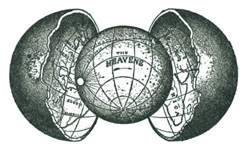By Professor J.A. Greenhill — February, 1901
 Clinton, Iowa: It is not to be supposed, nor even taken for granted, that all the facts connected with the phenomena presented in the study of astronomy, are fully and clearly understood by the scientist of to-day, yet it must be admitted that much of what is true and real is known and understood from the fact that the times of eclipses of the sun and moon can be, and are, calculated for centuries in the past or future, with unerring exactness. The occultation of stars by the moon is also correctly cataloged for years to come, showing clearly that astronomers are fully acquainted with the laws governing the motion of the heavenly bodies. These laws are inflexible, and based upon what is understood as the Copernican Theory, which teaches that our solar system is composed of the Sun, and all the planets with their satellites and “the comets also” that circle round that great central luminary. That all these bodies are opaque or dark globes, each turning on its axis, and receiving light on its side that is presented to the Sun.
Clinton, Iowa: It is not to be supposed, nor even taken for granted, that all the facts connected with the phenomena presented in the study of astronomy, are fully and clearly understood by the scientist of to-day, yet it must be admitted that much of what is true and real is known and understood from the fact that the times of eclipses of the sun and moon can be, and are, calculated for centuries in the past or future, with unerring exactness. The occultation of stars by the moon is also correctly cataloged for years to come, showing clearly that astronomers are fully acquainted with the laws governing the motion of the heavenly bodies. These laws are inflexible, and based upon what is understood as the Copernican Theory, which teaches that our solar system is composed of the Sun, and all the planets with their satellites and “the comets also” that circle round that great central luminary. That all these bodies are opaque or dark globes, each turning on its axis, and receiving light on its side that is presented to the Sun.
It is true we are not conscious of any motion of the earth, the globe upon which we dwelt; neither axial nor orbital; and we cannot even see far enough in the direction of the horizon to make sure of its globular form. But when we look upwards by the aid of the telescope, and see the other worlds, some much larger than ours, others not as large, all globular, and all turning round, no stopping nor turning backward, for the sake of making an occasional long day for murderous purposes, or curing boils, but moving with an exactness beyond the ingenuity of man to imitate. And when we see the contour of the earth, as its shadow steals over the moon at a lunar eclipse, we are justified in saying we know the earth is a globe, or large ball.
But these are not the only evidences we have that we are dwellers on the convex side of a globe. There are many others. For instance: When at the earth’s equator, the star Polaris—the north star—appears nearly stationary on the northern horizon, and the star in Orion’s belt nearest to Polaris, passes apparently westward directly across the zenith. As we come northward on the globe, Polaris rises from the horizon, and Orion goes south, and by the time we reach the latitude of Chicago, Polaris is 42° above the northern horizon, and the belt star passed 42° south from the zenith, or 48° above the southern horizon. And were it possible to reach what we could call the north pole of the earth, Polaris would appear directly overhead, and the belt star would appear to circle around it11 the horizon. From that station no star would appear to either rise or set, but would seem to move, similar objects fixed in the dome of an observatory when the top is being turned to bring the opening in front of the telescope. Or, like holding an umbrella upright overhead, and turning it slowly round by the handle. The zenith would seem stationary. The navigator can tell his latitude at any place on the ocean, from the altitude of Polaris.
Another evidence that we are living on the outside of a sphere is found in the fact that the civil engineer, in making his surveys, finds he has to make an allowance of eight inches convex curvature to a mile. A similar evidence can be obtained by going to a canal where several miles of a straight line can be had. Drive a row of stakes along its bank, at equal distances apart; the tops to be a like distance above the water in the canal. Now it is easy to understand that the line of tops of stakes will coincide with the line of water surface. With an ordinary telescope it will be seen that the contour of tops form a convex line; the water then must be convex on its surface. And as no one disputes the fact that still water always finds its level, the curvature is convex.
Other reasons could be adduced to prove that our earth is a globe, and that we are on its outside in the same sense that we expect to be understood when we see a fly walking on an apple, and say the fly is on the outside of the apple.
 These remarks are presented with a view of calling the attention of any of your readers who may have been fortunate, or otherwise, in seeing a pamphlet published in Chicago in 1898 by the Rev. Cyrus R. Teed, called Cellular Cosmogony. Which really ought to have been called Koreshean Nonsense. Which teaches that we are living on the inner surface of a ball that is eight thousand miles in diameter (right). Sun, Moon, Stars, Planets and everything else all inside. The shell of the ball is about 100 miles in thickness. To show your readers that I wish to be fair with Mr. Teed, I will quote from pages 166 and 167:
These remarks are presented with a view of calling the attention of any of your readers who may have been fortunate, or otherwise, in seeing a pamphlet published in Chicago in 1898 by the Rev. Cyrus R. Teed, called Cellular Cosmogony. Which really ought to have been called Koreshean Nonsense. Which teaches that we are living on the inner surface of a ball that is eight thousand miles in diameter (right). Sun, Moon, Stars, Planets and everything else all inside. The shell of the ball is about 100 miles in thickness. To show your readers that I wish to be fair with Mr. Teed, I will quote from pages 166 and 167:
“The shell of the earth is the circumference—the limit of the universe. It environs all that exists. Outside of the environment or limit of existence, there is nothing. There is no infinite space. There is nothing on the outside-no heat, cold, light, darkness, temperature, condition, entity, quality of substance-nothing. There couldn’t be.
“There is nothing outside to attract the earth, and hence it can never move out of the only space—place—there is. To do so would be to force the hollow globe into nothing.”
There you have it. The whole Copernican theory knocked into smithereens, and by a so-called educated gentleman who is certainly no fool, and yet, in face of the fact that if he would come to my observatory on the evening of the coming 27th of November, I would show him the planets Jupiter and Saturn in conjunction, in the southwest, near the horizon, and less than the apparent diameter of the moon apart. On Feb. 14th, 1902, I could show him the planet Venus, as a crescent-shaped body, eight degrees (8°) above the Sun at inferior conjunction. And on Nov. 20th, 1902, I could show him the same planet, full disc, six degrees (6°) above the Sun. All calculations based upon the correctness of the Copernican Theory; and always correct. It may appear unnecessary to be at any trouble to controvert such an absurdity, were it not that the reverend gentleman is undoubtedly playing upon the credulity of his fellows with a view to get as large a following as possible, so as to get of their means whereby he can support himself without having to resort to muscular effort.





